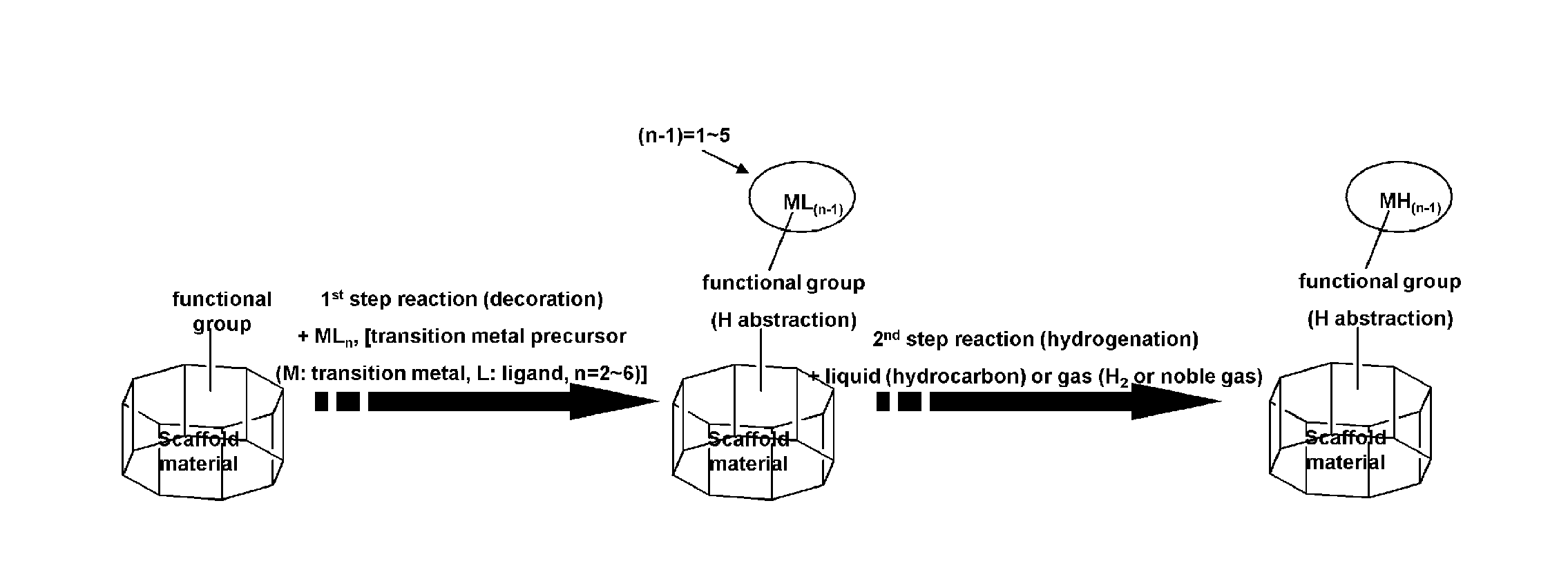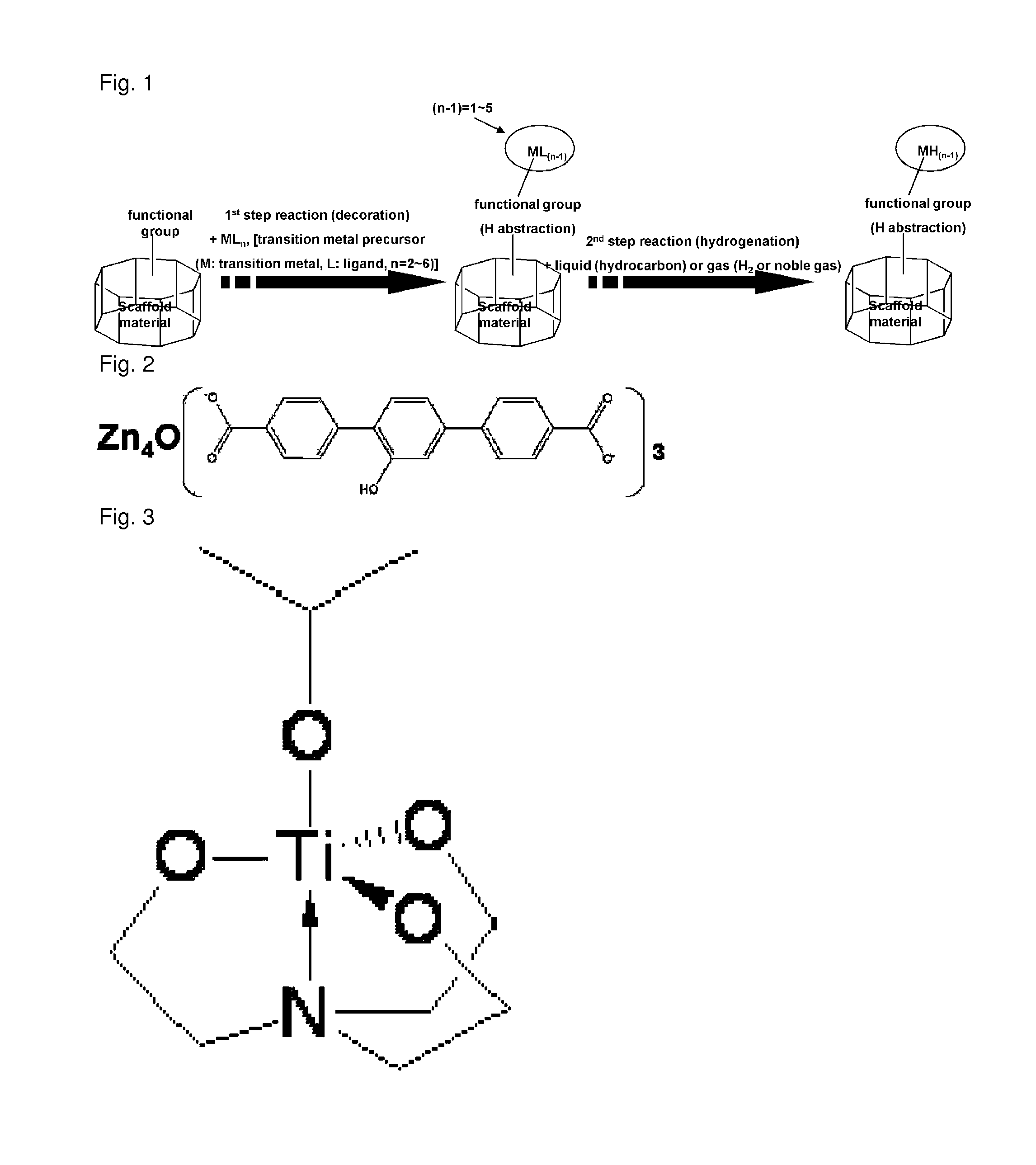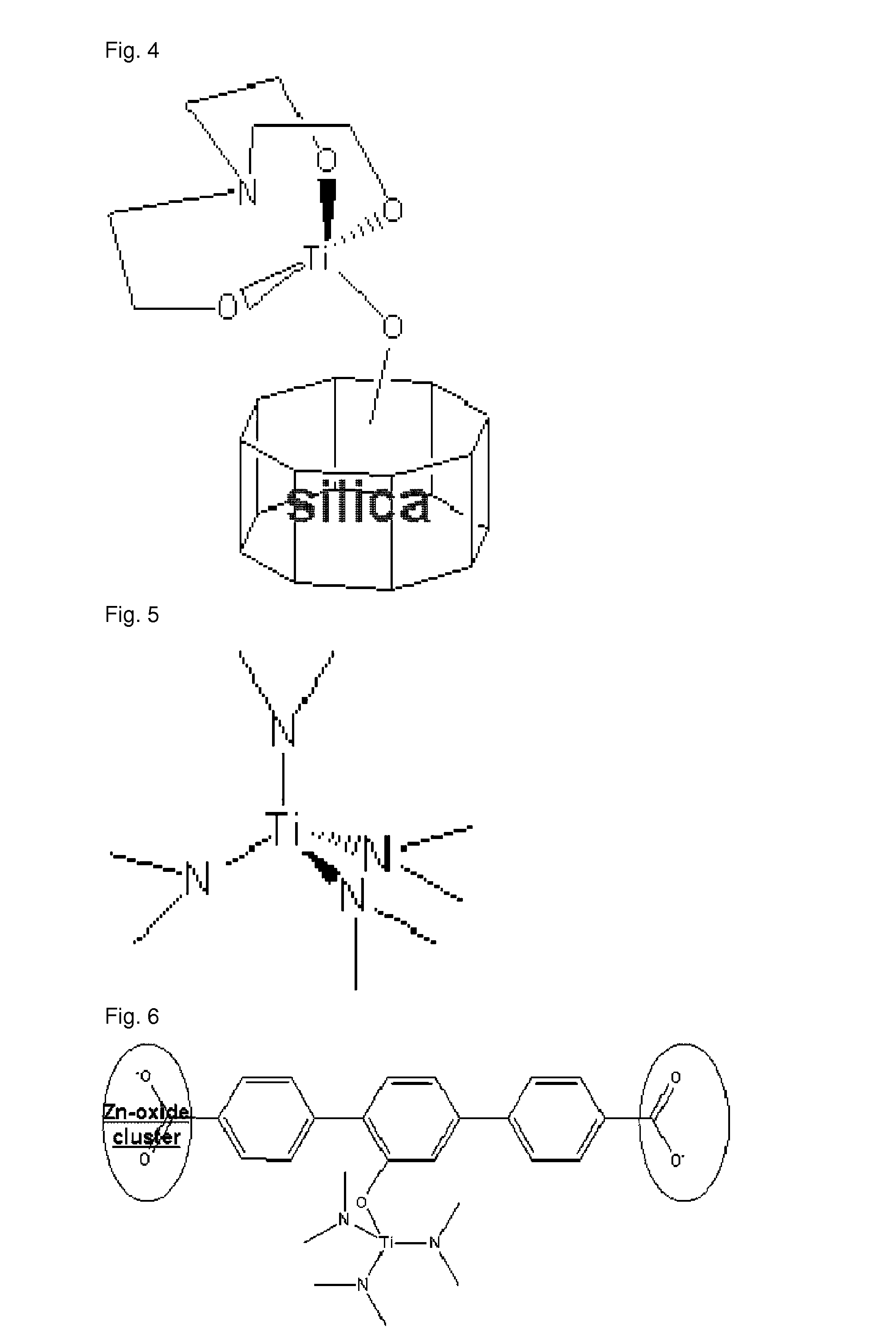Scaffold materials-transition metal hydride complexes, intermediates therefor and method for preparing the same
a technology of metal hydride complexes and composite materials, which is applied in the field of composite materials-transition metal hydride complexes, intermediates therefor and method for preparing the same, can solve the problems of difficult commercial use, disintegration of materials, and relative harsh conditions for hydrogen adsorption/desorption, and achieve excellent sublimation properties, easy removal, and easy handling
- Summary
- Abstract
- Description
- Claims
- Application Information
AI Technical Summary
Benefits of technology
Problems solved by technology
Method used
Image
Examples
example 1
[0109]
(1) Synthesis of Metal Organic Framework Material (Modified MOF): Zn4O(C8H4O5)3
[0110]In a 250 mL two-necked round bottomed flask, charged were 2-hydroxy-1,4-benzenedicarboxylic acid (4.1 mmol) and zinc nitrate tetrahydrate (11.0 mmol) under nitrogen atmosphere, and the mixture was dissolved in 100 mL of dimethylformamide (DMF). In a closed vessel, the solution was subjected to reaction at 100° C. for 20 hours. Purification by using chloroform and drying under reduced pressure gave metal organic framework containing hydroxyl groups. Yield: 80%. FT-IR: 3400(br). Elemental analysis (EA) (% calc / found): C, 35.2 / 35.3; H, 1.48 / 2.00. XRF (% calc / found): Zn, 32.0 / 30.8.
(2) Synthesis of Metal Organic Framework-Transition Metal Halide Complex [SM: Metal Organic Framework, Product: Zn4O(C8H3O5TiCl3)3]
[0111]In a two-necked flask (250 mL) equipped with a magnetic stirrer and a condenser, charged were metal organic framework material (4 mmol) containing hydroxyl groups [prepared from stage ...
example 2
(1) Preparation of Multiwall Carbon Nanotube (MWCNT)-[O,COO]-transition metal Halide Complex [SM: Multiwall Carbon Nanotubes Containing —OH Groups and —COOH Groups on the Surface (—OH &—COOH Groups: 6 wt %)
[0113]Multiwall carbon nanotubes containing —OH groups and —COOH groups on the surface (—OH &—COOH groups: 6 wt %) can be prepared by applying various processes for surface modification proposed by Korean Patent No. 10-2008-0117106. The present example is prepared by applying one of them. Specific description is given below.
[0114]Multiwall carbon nanotubes (12 g) (referred to as MWCNT hereinbelow)(trade name: CM95, from Hanwha Nanotech) was mixed with distilled water (988 g) by using a circulation pump to prepare MWCNT solution in a pretreatment vessel. Before incorporating the MWCNT solution to a preheating vessel at a flow rate of 30 g / min through high pressure injection pump, the MWCNT solution was mixed with compressed gaseous oxygen at 245 atm ˜252 atm via shear of a heat exc...
example 3
(1) Preparation of mesoporous silica-O-transition metal halide complex [SM: Mesoporous Silica Containing —OH Groups on the Surface (—OH Group 1 mmol / g)]
[0125]In a two-necked round-bottomed flask (250 mL), mesoporous silica containing —OH groups on the surface (—OH group 1 mmol / g) (XPO-2410 from GRACE DAVISON) (0.5 g) was added to 50 ml toluene under argon atmosphere to prepare Reactant E. In a one-necked round-bottomed flask (100 mL), 1M TiCl4 (solvent: toluene) (1.3 mL) was dissolved in 30 mL of toluene to prepare Reactant F. After stirring Reactant E for 1 hour, Reactant F was slowly added dropwise thereto, and the mixture was heated under reflux at 50° C. for 18 hours. Under argon atmosphere, toluene as reaction solvent was removed under reduced pressure, and unreacted TiCl4 was filtered off by using toluene. Removal of toluene under reduced pressure gave Product C. Yield: 99%. Anal. Calc. (XRF): Si, 47.76; Ti, 4.15. Anal. Found (XRF): Si, 46.73; Ti, 4.57%.
[0126]As the result of ...
PUM
| Property | Measurement | Unit |
|---|---|---|
| temperature | aaaaa | aaaaa |
| pressure | aaaaa | aaaaa |
| temperature | aaaaa | aaaaa |
Abstract
Description
Claims
Application Information
 Login to View More
Login to View More - R&D
- Intellectual Property
- Life Sciences
- Materials
- Tech Scout
- Unparalleled Data Quality
- Higher Quality Content
- 60% Fewer Hallucinations
Browse by: Latest US Patents, China's latest patents, Technical Efficacy Thesaurus, Application Domain, Technology Topic, Popular Technical Reports.
© 2025 PatSnap. All rights reserved.Legal|Privacy policy|Modern Slavery Act Transparency Statement|Sitemap|About US| Contact US: help@patsnap.com



